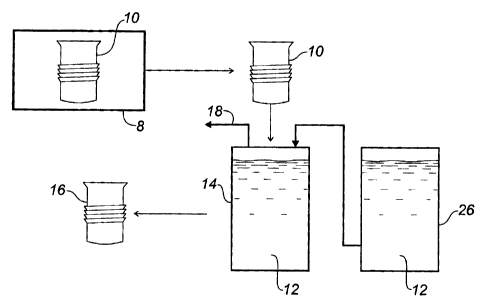Une partie des informations de ce site Web a été fournie par des sources externes. Le gouvernement du Canada n'assume aucune responsabilité concernant la précision, l'actualité ou la fiabilité des informations fournies par les sources externes. Les utilisateurs qui désirent employer cette information devraient consulter directement la source des informations. Le contenu fourni par les sources externes n'est pas assujetti aux exigences sur les langues officielles, la protection des renseignements personnels et l'accessibilité.
L'apparition de différences dans le texte et l'image des Revendications et de l'Abrégé dépend du moment auquel le document est publié. Les textes des Revendications et de l'Abrégé sont affichés :
| (12) Brevet: | (11) CA 2240226 |
|---|---|
| (54) Titre français: | CHEVILLE EN MATIERE PLASTIQUE POLYMERIQUE IMPREGNEE D'UN PRODUIT DE PRESERVATION DU BOIS, ET METHODE DE FABRICATION CONNEXE |
| (54) Titre anglais: | POLYMER PLASTIC PLUG IMPREGNATED WITH WOOD PRESERVATIVE AND METHOD FOR MAKING THE SAME |
| Statut: | Périmé |
| (51) Classification internationale des brevets (CIB): |
|
|---|---|
| (72) Inventeurs : |
|
| (73) Titulaires : |
|
| (71) Demandeurs : |
|
| (74) Agent: | WOODRUFF, NATHAN V. |
| (74) Co-agent: | |
| (45) Délivré: | 2009-03-24 |
| (22) Date de dépôt: | 1998-06-10 |
| (41) Mise à la disponibilité du public: | 1999-12-10 |
| Requête d'examen: | 2003-06-06 |
| Licence disponible: | S.O. |
| (25) Langue des documents déposés: | Anglais |
| Traité de coopération en matière de brevets (PCT): | Non |
|---|
| (30) Données de priorité de la demande: | S.O. |
|---|
Méthode pour imprégner une cheville en plastique polymérique avec un agent de préservation du bois. La première étape consiste à déshydrater une cheville en plastique polymérique afin de réduire son taux d'humidité naturel. La deuxième étape consiste à introduire l'agent de préservation du bois liquide dans la cheville en plastique polymérique pendant que cette cheville est à l'état déshydraté, cela en immergeant celle-ci dans l'agent de préservation du bois liquide que l'on fait bouillir à des températures inférieures à celles requises pour que la cheville en plastique polymérique fonde. Selon cette méthode, l'agent de préservation du bois liquide est absorbé dans la cheville en plastique polymérique, où il remplace l'humidité présente naturellement.
A method of impregnating a polymer plastic plug with wood preservative. A first step involves dehydrating a polymer plastic plug to reduce its naturally occurring moisture content. A second step involves introducing liquid wood preservative into the polymer plastic plug while the polymer plastic plug is in a dehydrated state by immersing it in the liquid wood preservative and boiling the liquid wood preservative at temperatures that are less than that required to turn the polymer plastic plug into a molten state. In accordance with the teachings of this method liquid wood preservative is absorbed into the dehydrated polymer plastic plug in place of the naturally occurring moisture content.
Note : Les revendications sont présentées dans la langue officielle dans laquelle elles ont été soumises.
Note : Les descriptions sont présentées dans la langue officielle dans laquelle elles ont été soumises.

Pour une meilleure compréhension de l'état de la demande ou brevet qui figure sur cette page, la rubrique Mise en garde , et les descriptions de Brevet , États administratifs , Taxes périodiques et Historique des paiements devraient être consultées.
| Titre | Date |
|---|---|
| Date de délivrance prévu | 2009-03-24 |
| (22) Dépôt | 1998-06-10 |
| (41) Mise à la disponibilité du public | 1999-12-10 |
| Requête d'examen | 2003-06-06 |
| (45) Délivré | 2009-03-24 |
| Expiré | 2018-06-11 |
| Date d'abandonnement | Raison | Reinstatement Date |
|---|---|---|
| 2007-12-20 | R30(2) - Absence de réponse | 2008-05-12 |
Les titulaires actuels et antérieures au dossier sont affichés en ordre alphabétique.
| Titulaires actuels au dossier |
|---|
| 1824930 ALBERTA LTD |
| Titulaires antérieures au dossier |
|---|
| GENICS INC. |
| GENICS-CAN INC. |
| WALL, WESLEY JAMES |